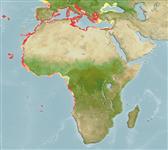Environment: milieu / climate zone / Tiefenbereich / distribution range
Ökologie
seewasser pelagic-neritic; tiefenbereich 0 - 100 m (Ref. 27000), usually ? - 50 m (Ref. 6949). Subtropical; 48°N - 18°S, 31°W - 37°E
Eastern Atlantic: Bay of Biscay to Mossamedes, Angola, including the Mediterranean and Black Sea, Canary Islands, and Azores. Western Atlantic: Bermuda and Brazil.
Length at first maturity / Size / Gewicht / Alter
Geschlechtsreife: Lm 27.6 range ? - ? cm
Max length : 165 cm TL Männchen/unbestimmt; (Ref. 3397); common length : 60.0 cm SL Männchen/unbestimmt; (Ref. 11101); max. veröff. Gewicht: 3.6 kg (Ref. 40637)
Found in coastal and offshore waters (Ref. 2683). Feeds mostly on fish, less often on cephalopods and crustaceans (Ref. 11101).
De Sylva, D.P., 1990. Sphyraenidae. p. 860-864. In J.C. Quero, J.C. Hureau, C. Karrer, A. Post and L. Saldanha (eds.) Check-list of the fishes of the eastern tropical Atlantic (CLOFETA). JNICT, Lisbon; SEI, Paris; and UNESCO, Paris. Vol. 2. (Ref. 6949)
IUCN Rote Liste Status (Ref. 130435: Version 2025-1)
Bedrohung für Menschen
Harmless
Nutzung durch Menschen
Fischereien: weniger kommerziell; Sportfisch: ja
Tools
Zusatzinformationen
Download XML
Internet Quellen
Estimates based on models
Preferred temperature (Ref.
123201): 14.3 - 21.9, mean 18.3 °C (based on 126 cells).
Phylogenetic diversity index (Ref.
82804): PD
50 = 0.5000 [Uniqueness, from 0.5 = low to 2.0 = high].
Bayesian length-weight: a=0.00759 (0.00618 - 0.00931), b=2.92 (2.88 - 2.96), in cm total length, based on LWR estimates for this species (Ref.
93245).
Trophic level (Ref.
69278): 4.0 ±0.51 se; based on food items.
Widerstandsfähigkeit (Ref.
120179): niedrig, Verdopplung der Population dauert 4,5 - 14 Jahre. (K= 0.123; Tmax >8 yrs).
Fishing Vulnerability (Ref.
59153): Very high vulnerability (90 of 100).
🛈
Nutrients (Ref.
124155): Calcium = 24.6 [10.3, 69.4] mg/100g; Iron = 0.664 [0.275, 1.476] mg/100g; Protein = 20.6 [18.5, 22.4] %; Omega3 = 0.212 [0.091, 0.512] g/100g; Selenium = 28.7 [11.1, 78.2] μg/100g; VitaminA = 3.9 [0.6, 26.7] μg/100g; Zinc = 0.282 [0.169, 0.509] mg/100g (wet weight);
